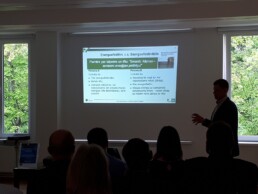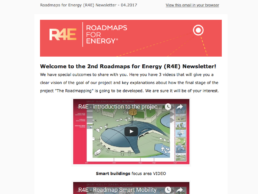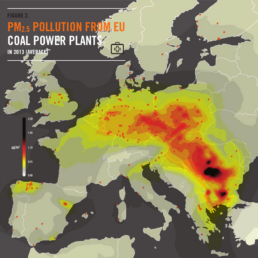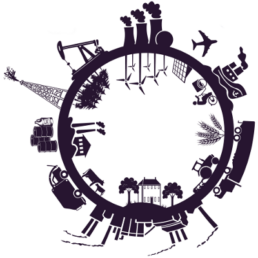Training for energy managers is implemented in Vidzeme (Latvia): 18 local governments and the regional hospital have already engaged
At the end of April, in Smiltene, 18 local governments of Vidzeme commenced their participation in the set of activities “Energy Management in Vidzeme” to improve their knowledge on the operation and management of energy handling facilities. During the first training session, great attention was paid to data collection and creating a database, acquainting training participants with data collection, processing and analysis methods and opportunities to use them for introduction of energy efficient solutions in local governments.Read more
Inwestycje Energetyczne - spis inwestycji energetycznych w Polsce.
Koło Naukowe Energetyków Politechniki Warszawskiej serdecznie zaprasza do odwiedzenia strony Inwestycje Energetyczne. Jest to projekt zrealizowany przez członków koła, którego celem było stworzenie ogólnodostępnego portalu internetowego o obecnie realizowanych inwestycjach energetycznych w Krajowy System Energetyczny. Po wejściu na stronę ukaże się nam mapa konturowa Polski, na której zaznaczone zostały obiekty wykorzystujące odnawialne i nieodnawialne źródła energii, sieci elektryczne i stacje rozdzielcze, a także magazyny gazu i informacje o potencjalnych miejscach budowy elektrowni jądrowej. Obiekty reprezentują symbole informujące o źródle energii wykorzystywanym w obiekcie. Po otwarciu strony z daną inwestycją ukażą się takie informacje jak:
- Ramy czasowe inwestycji, a także moc zainstalowana
- Inwestor i Wykonawca,
- Oś czasu najważniejszych wydarzeń w inwestycji,
- Informacje o finansach i technologii,
- Krótka nota o aktualnym stanie budowlanym,
- Bibliografia.
Strona jest regularnie odświeżana i rozbudowywana o nowe inwestycje. Strona współpracuje m.in z takimi firmami jak Orlen, Wärtsilä, czy Siemens.
Strona obsługuje także urządzenia mobilne.
Bezpośredni link do strony: http://inwestycjeenergetyczne.itc.pw.edu.pl/
Koło Naukowe Energetyków serdecznie zaprasza!
EFdeN - the team of young profesionals
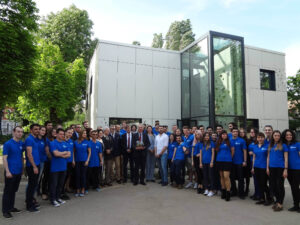
Who are we?
We are a team of young profesionals working interdisciplinary with the aim of changing mentalities and housing conditions, while increasing energy efficiency in Romania.
What did we do?
In 2014 we represented Romania with EFdeN solar house prototype in the final round of the international competition Solar Decathlon Europe in France competing with other 19 teams from 16 countries and 4 continents. We had to pass through 10 interdisciplinary contests from architecture, engineering, innovation and communication.
We designed and built solar house EFdeN that is safe and confortable, energy efficient, 100% with no monthly bills, automated and environmentally friendly.

What do we do for now?
After hard work and dedication, EFdeN is the first Center of Research of Comfort Conditions in Romania and you can visit us every Sunday to Bvd. Pache Protopopescu, nr.66, in Bucharest.
We develop for now 10 programs of sustainability, energy efficiency, education and electric transportation.
You can find more details on our website: 10 EFdeN programs
EnergiaTa - every Romanian has the right to produce his own electrical energy

The story of EnergiaTa program began last year in EFdeN project, starting from EFdeN solar house prototype designed and built by students which participated in the international competition Solar Decathlon Europe, in Versailles. In order to built our solar house, we learnt about energy efficiency, sustainability, legislation, interior comfort, the impact of the materials used on our health and the environment. In all this process, we realized that 80% of the time we spent in buildings which are far away from what it should be namely sustainable, safe, confortable, energy efficient and environmentally friendly.
With other words, we gathered knowledge from many fields and we discovered some difficulties many Romanian people encounter trying to exercise the right of producing their own green energy. These challenges, EnergiaTa team, transformed in objectives which want to implement as soon as possible talking to different entities who have the possibility to support the proposed changes.
The EnergiaTa team militate for legislative changes which have the purpose of improving the administrative procedure, namely reducing the high number of necessary approvals for obtaining the autorization of equipping with photovoltaic panels for rezidential sector and the large amount of waiting time which is more than 450 days. Also we militate for creating a favorable legislative framework in order to have the possibility of introducing the whole produced energy or the excess of it from the small producers of energy from renewables in the national power grid and of course obtaining a support scheme for the introduced energy.
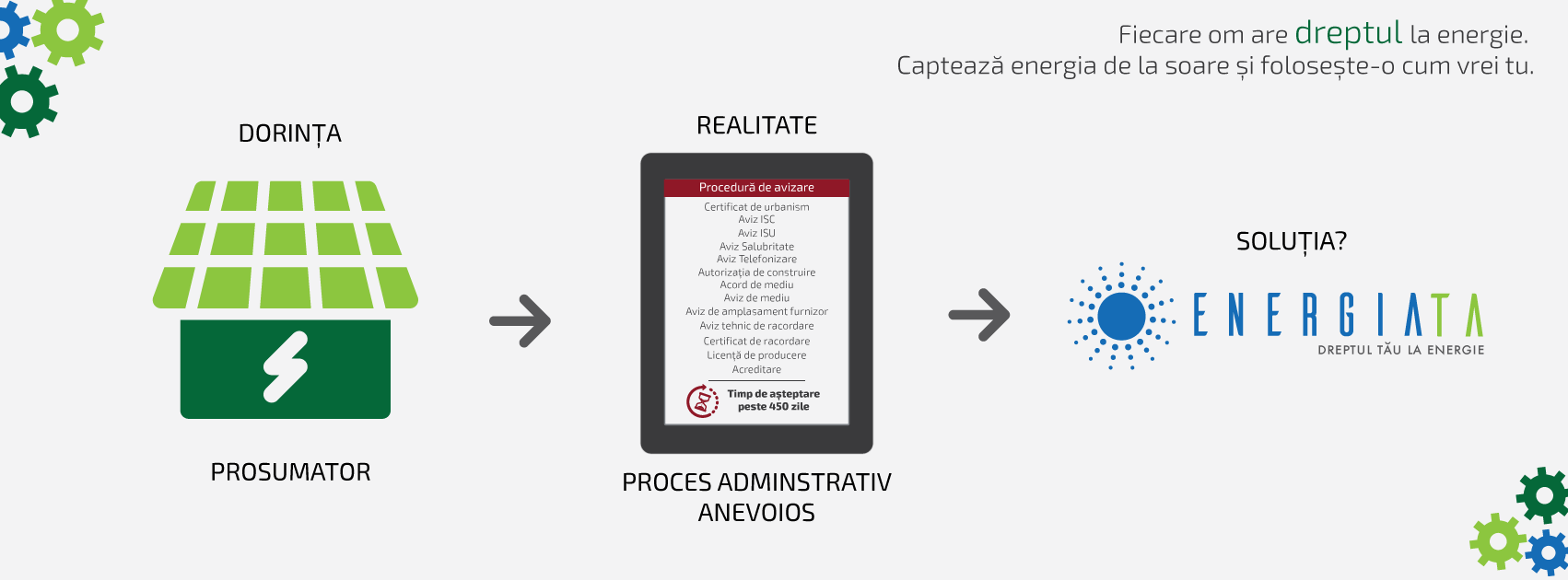
One success of EnergiaTa team was reached last year by introducing in the Energy National Strategy the concept of prosumer, namely that every Romanian can produce, consume his own energy and introduce if it's the case, the excess of energy in the national power grid. We believe this success has a great importance for the Romanian energy future because certifies the right of Romanian people to become small producers of energy from renewables.
For being introduced a large quantity of energy which can influence the shape of load curve, it is necessary that transport and distribution operators modernize and develop electric grids as intelligent grids, able to interact in real time with prosumers. Moreover, it's a must of having grid management systems to give a quick answer to price changes, local differencies of the price and also the visibility in real time of prosumers' reactions.
An important obstacle for everyone who wants to equip their house with photovoltaic panels represents the legislation, but EnergiaTa team propose to bring significant changes which will place Romania in the top of the countries which use green energy and develop communities of prosumers!
Reading list: 2nd Roadmaps for Energy (R4E) Newsletter
R4E project is sharing some interesting results of their work: 2nd R4E Newsletter
Earth Hour Hungary
Earth Hour is an event started in 2007 and became the largest grassroot movement for environment.
foldoraja.hu
CEESEN platform now in 11 languages
CEESEN platform is available in:
Austrian, Bulgarian, Czech, English, Estonian, Hungarian, Latvian, Lithuanian, Macedonian, Polish, Romanian and Slovenian language.
Join free at ceesen.org!
EUSEW 19-25 June 2017
European Sustainable Energy Week is happening on 19-25 June 2017.
Conference, networking, awards, Energy Days and more.
http://eusew.eu
Roadmaps for Energy (R4E)
Roadmaps for Energy (R4E) is an EU funded project under the Horizon 2020 programme that aims to develop a new type of energy strategy through visions and roadmaps for the 8 partner cities, in co-creation with relevant local stakeholders. The project focuses on three areas within the domain of sustainable energy that are closely linked to the municipalities main responsibilities:
- Smart buildings
- Smart mobility
- Smart urban spaces
For more information visit: http://roadmapsforenergy.eu
ETIP SNET is calling for experts (deadline January 20th)
The European Technology and Innovation Platform Smart Networks for Energy Transition (ETIP SNET) is aiming to elaborate a vision and roadmap for R&I activities for smart networks, storage and other sources of flexibility in integrated energy systems. For this reason ETIP SNET is now seeking experts to take an active part in five of the six Working Groups it has launched. Experts may come from academia, industry, public administration and else where in order to represent the widest community of stakeholders related to their area of expertise. They are therefore encouraged to apply to the Working Groups where their contribution can have most impact in the context of the wider European energy system. To learn more about the Working Groups please visit: http://etip-snet/working-groups.html. The summaries that appear will also link to a downloadable PDF with the full Terms of Reference for each Group. If you have expertise and are wiling to contribute to ETIP SNET´s vision please send us your candidature by Friday 20 January 2017 through the following link:https://goo.gl/5o1VRa
Source: ETIP SNET
HEAL: coal power plants are causing premature death
Health and Environment Alliance (HEAL), Climate Action Network (CAN) Europe, the WWF European Policy Office and Sandbag published a study in 2016 that links 22 900 premature deaths with the impact of coal fired power plants in Europe. Most of these plants are located in CEE countries that face the strongest negative impact on peoples health. Read more: https://drive.google.com/file/d/0B61Z9fHPRFJgUktzU3BfRWkzbk0/view?usp=sharing
CEESEN in 2017
Many exciting things are ahead of us in 2017:
Regional Trainings in Energy Advocacy in CEE countries.
Guidebook on Energy Efficiency Advocacy.
EUSEW in Brussels and CEE countries.
CEESEN conference in Prague, Cz.
Stay tuned!
Energy Efficiency Finance Market Place
The event will bring together key stakeholders from cities, regions and industry as well as the financial sector to discuss successful schemes implemented at local and regional level, financing mechanisms and products available, and practical challenges to implement them on a large scale. A special focus will be on structuring the market and, in particular, standardisation, aggregation and de-risking of energy efficiency assets.
More information: https://ec.europa.eu/energy/en/events/energy-efficient-finance-market-place
Merry Christmas and Happy New Year!
Dear members of CEESEN
behalf of PANEL2050 project and Tartu Regional Energy Agency we wish you
Merry Christmas
and
Happy New Year of 2017!
Sincerely,
Marek Muiste
PANEL2050 coordinator
The Future of National Energy Policies introduced in Tallinn, Estonia
Introduction of CEESEN in Russia, Belarus, Moldova and Georgia
Prepare and hold one public event in Russia, Belarus, Moldova and Georgia. Agenda:
- introduction of CEESEN;
- local Roadmaps for 2050;
- Curriculum for trainings;
- Guidebook for Energy Advocacy.
Public lecture in Tartu, Estonia on Global Production Chains on Feb 15th of 2017
Public lecture in Tartu, Estonia on Global Production Chains at 18:00 on Feb 15th of 2017. List of topics:
- scope and scale of Global Production Chains today and
- how is it different from MadeInChina model?
- history, dynamics and impact of global production models;
- possibilities for local economy.
Speaker: Marek Muiste (Estonian University of Life Sciences, Tartu Regional Energy Agency).
The lecture is held in Estonian.
Event is supported by Tartu loodusmaja, Estonian Environmental Investment Centre, Tartu Regional Energy Agency and City of Tartu.
"Energy Efficiency Finance Market Place" - 18-19 January 2017, Brussels
"Energy Efficiency Finance Market Place" - 18-19 January 2017, Brussels
On the 18 and 19 January 2017, EASME(The Executive Agency for Small and Medium-sized Enterprises) is organising in Brussels a major event on energy efficiency finance. This event will showcase best practice examples regarding the private financing of energy efficiency projects and programmes, and will provide networking opportunities for participants from different areas (finance and insurance sector, energy service companies, consultants, public sector). In particular, EASME wants to create an "energy efficiency finance market place" where financing institutions can present their relevant products and discuss with project developers on financing opportunities and strategic partnerships.
Accelerated investment in energy efficiency and renewable energy is key to meet the European Union’s energy and climate targets for 2030 and has significant benefits for European citizens and companies in terms of jobs and sustainable growth, lower energy bills, health and security of energy supply. Energy efficiency is also a major business opportunity which is not yet fully exploited.
The event will bring together key stakeholders from cities, regions and industry as well as the financial sector to discuss successful schemes implemented at local and regional level, financing mechanisms and products available, and practical challenges to implement them on a large scale. A special focus will be on structuring the market and, in particular, standardisation, aggregation and de-risking of energy efficiency assets.
The conference is the third in a series of successfull events during the last years and will feature:
- Plenary sessions by high-level political representatives on finance for sustainable energy;
- Panel sessions by financial institutions on practical experiences and project bankability;
- Parallel sessions on practical solutions and projects implemented across Europe in four thematic tracks:
- Standardisation and benchmarking;
- Innovative financing solutions;
- Aggregating projects on public assets;
- Aggregating projects on private assets; - Poster sessions of sustainable energy projects with divers technical and financial structures; as well as
- Stands of financial institutions.
Organisations with experience in sustainable energy financing, including energy efficiency are encouraged to express their interest until 07/12/2016 on https://ec.europa.eu/eusurvey/runner/ee-financing-market-place-2017
EeB-CA2 Matchmaking Event "Energy-efficient Buildings“
On 18th November 2016 the EeB-CA2 matchmaking event takes place, in which innovative stakeholders from across Europe along the whole value chain of energy-efficient buildings and building technologies will get together. From the planning office and research partners of EU projects over manufacturers to municipalities and investors – the EeB-CA2 matchmaking event is your occasion to quickly get in contact and exchange about new ideas for research and innovation projects and business relations.
How is this matchmaking event organised?
Register yourself via the event’s website, upload a meaningful profile of your organization, including a cooperation and technology offer or request. Between 1st -14th November you can book in advance bilateral meetings with other registered participants. At the registration desk of the event location you will then receive your individual meeting schedule.
Further information, registration and an overview of the profiles of all registered participants can be found here: https://www.b2match.eu/eebca2
Deadline for registration: 14th November 2016
Bilateral meetings can be booked in advance between November 1-14 2016.
The event is free of charge. It will be held in parallel to the ECTP Conference – if you would like to participate in this event as well please register separately via the ECTP website (https://fr.xing-events.com/ECTPConference2016.html).
Contact:
Franziska Bergmann
Tel.: +49 (0)721/93519118
bergmann@steinbeis-europa.de
A doua întâlnire de proiect PANEL 2050 și sesiune train the trainers
A 2-a ședință de proiect și de formare a proiectului va cuprinde:
Locație: Levalaukis Homestead Resort, Ignalina, Lithuania
Data eveniment: 3-7 Octombrie 2016
Vezi mai mult aici
G20 reaffirms climate commitment and energy collaboration at China summit
Climate change and energy cooperation were high on the agenda at the meeting of the world's major advanced and emerging economies in Hangzhou, China, from 4-5 September 2016.
The Group of 20 (G20) reiterated their commitment to sustainable development, strong and effective support and actions to address climate change.
In the communiqué adopted at the meeting, the G20 also reaffirmed the importance of energy collaboration for a cleaner energy future and sustainable energy security that also fosters economic growth.
The US and China – the world’s two biggest emitters, together responsible for almost 40% of the world's carbon emissions – both ratified the Paris Agreement on climate change in advance of the meeting.
In the communiqué, the G20 welcomed efforts by members to enable the Paris Agreement to enter into force by the end of 2016 and committed to complete their respective domestic procedures as soon as national procedures allow. They stressed the importance of fulfilling the commitment by developed countries to provide means of implementation including financial resources to assist developing countries with respect to both mitigation and adaptation actions in line with the Paris outcomes.
The summit also highlighted the need to scale up green financing and for continued investment in energy projects to ensure future energy security and prevent economically destabilising price spikes.
G20 countries were encouraged to significantly improve energy efficiency based on the specific needs and national circumstances of each member and promote energy conservation through appropriate lifestyle changes.
In its communiqué, the group of 20 said it looked forward to successful outcomes in related multilateral fora, including the Montreal Protocol and the International Civil Aviation Organization on action to reduce global greenhouse gas emissions.
Source: https://ec.europa.eu/energy/en/news/g20-reaffirm-climate-commitment-and-energy-collaboration-china-summit
2. project meeting and training of PANEL2050
2nd project meeting and training will contain:
- project meeting and SC meeting, introduction of training activities
- Energy Planning and Roadmaps in PANEL2050 training
- Engagement training
Train the Trainer Workshops for partners. Some partners lack experience in teaching or conducting trainings while others have teaching experience but lack knowledge in political advocacy. This will focus on the use of participatory teaching methods and the selection of examples from the local region to use as problems for students to work through. Participants will also practice leading in-class discussions to further prepare them for running the workshops.
New solar cell is more efficient, costs less than its counterparts
The cost of solar power is beginning to reach price parity with cheaper fossil fuel-based electricity in many parts of the world, yet the clean energy source still accounts for just slightly more than 1 percent of the world's electricity mix.
Solar, or photovoltaic (PV), cells, which convert sunlight into electrical energy, have a large role to play in boosting solar power generation globally, but researchers still face limitations to scaling up this technology. For example, developing very high-efficiency solar cells that can convert a significant amount of sunlight into usable electrical energy at very low costs remains a significant challenge.
A team of researchers from MIT and the Masdar Institute of Science and Technology may have found a way around this seemingly intractable tradeoff between efficiency and cost. The team has developed a new solar cell that combines two different layers of sunlight-absorbing material to harvest a broader range of the sun's energy. The researchers call the device a "step cell," because the two layers are arranged in a stepwise fashion, with the lower layer jutting out beneath the upper layer, in order to expose both layers to incoming sunlight. Such layered, or "multijunction," solar cells are typically expensive to manufacture, but the researchers also used a novel, low-cost manufacturing process for their step cell.
The team's step-cell concept can reach theoretical efficiencies above 40 percent and estimated practical efficiencies of 35 percent, prompting the team's principal investigators -- Masdar Institute's Ammar Nayfeh, associate professor of electrical engineering and computer science, and MIT's Eugene Fitzgerald, the Merton C. Flemings-SMA Professor of Materials Science and Engineering -- to plan a startup company to commercialize the promising solar cell.
Fitzgerald, who has launched several startups, including AmberWave Systems Corporation, Paradigm Research LLC, and 4Power LLC, thinks the step cells might be ready for the PV market within the next year or two.
The team presented its initial proof-of-concept step cell in June at the 43rd IEEE Photovoltaic Specialists Conference in Portland, Oregon. The researchers have also reported their findings at the 40th and 42nd annual conferences, and in the Journal of Applied Physics and IEEE Journal of Photovoltaics.
Beyond silicon
Traditional silicon crystalline solar cells, which have been touted as the industry's gold standard in terms of efficiency for over a decade, are relatively cheap to manufacture, but they are not very efficient at converting sunlight into electricity. On average, solar panels made from silicon-based solar cells convert between 15 and 20 percent of the sun's energy into usable electricity.
Silicon's low sunlight-to-electrical energy efficiency is partially due to a property known as its bandgap, which prevents the semiconductor from efficiently converting higher-energy photons, such as those emitted by blue, green, and yellow light waves, into electrical energy. Instead, only the lower-energy photons, such as those emitted by the longer red light waves, are efficiently converted into electricity.
To harness more of the sun's higher-energy photons, scientists have explored different semiconductor materials, such as gallium arsenide and gallium phosphide. While these semiconductors have reached higher efficiencies than silicon, the highest-efficiency solar cells have been made by layering different semiconductor materials on top of each other and fine-tuning them so that each can absorb a different slice of the electromagnetic spectrum.
These layered solar cells can reach theoretical efficiencies upward of 50 percent, but their very high manufacturing costs have relegated their use to niche applications, such as on satellites, where high costs are less important than low weight and high efficiency.
The Masdar Institute-MIT step cell, in contrast, can be manufactured at a fraction of the cost because a key component is fabricated on a substrate that can be reused. The device may thus help boost commercial applications of high-efficiency, multijunction solar cells at the industrial level.
Steps to success
The step cell is made by layering a gallium arsenide phosphide-based solar cell, consisting of a semiconductor material that absorbs and efficiently converts higher-energy photons, on a low-cost silicon solar cell.
The silicon layer is exposed, appearing like a bottom step. This intentional step design allows the top gallium arsenide phosphide (GaAsP) layer to absorb the high-energy photons (from blue, green, and yellow light) leaving the bottom silicon layer free to absorb lower-energy photons (from red light) not only transmitted through top layers but also from the entire visible light spectrum.
"We realized that when the top gallium arsenide phosphide layer completely covered the bottom silicon layer, the lower-energy photons were absorbed by the silicon germanium -- the substrate on which the gallium arsenide phosphide is grown -- and thus the solar cell had a much lower efficiency," explains Sabina Abdul Hadi, a PhD student at Masdar Institute whose doctoral dissertation provided the foundational research for the step-cell. "By etching away the top layer and exposing some of the silicon layer, we were able to increase the efficiency considerably."
Working under Nayfeh's supervision, Abdul Hadi conducted simulations based on experimental results to determine the optimal levels and geometrical configuration of the GaAsP layer on silicon to yield the highest efficiencies. Her findings resulted in the team's initial proof-of-concept solar cell. Abdul Hadi will continue supporting the step cell's technological development as a post-doctoral researcher at Masdar Institute.
On the MIT side, the team developed the GaAsP, which they did by growing the semiconductor alloy on a substrate made of silicon germanium (SiGe).
"Gallium arsenide phosphide cannot be grown directly on silicon, because its crystal lattices differ considerably from silicon's, so the silicon crystals become degraded. That's why we grew the gallium arsenide phosphide on the silicon germanium -- it provides a more stable base," explains Nayfeh.
The problem with the silicon germanium under the GaAsP layer is that SiGe absorbs the lower-energy light waves before it reaches the bottom silicon layer, and SiGe does not convert these low-energy light waves into current.
"To get around the optical problem posed by the silicon germanium, we developed the idea of the step cell, which allows us to leverage the different energy absorption bands of gallium arsenide phosphate and silicon," says Nayfeh.
The step cell concept led to an improved cell in which the SiGe template is removed and re-used, creating a solar cell in which GaAsP cell tiles are directly on top of a silicon cell. The step-cell allows for SiGe reuse since the GaAsP cell tiles can be under-cut during the transfer process. Explaining the future low-cost fabrication process, Fitzgerald says: "We grew the gallium arsenide phosphide on top of the silicon germanium, patterned it in the optimized geometric configuration, and bonded it to a silicon cell. Then we etched through the patterned channels and lifted off the silicon germanium alloys on silicon. What remains then, is a high-efficiency tandem solar cell and a silicon germanium template, ready to be reused."
Because the tandem cell is bonded together, rather than created as a monolithic solar cell (where all layers are grown onto a single substrate), the SiGe can be removed and reused repeatedly, which significantly reduces the manufacturing costs.
"Adding that one layer of the gallium arsenide phosphide can really boost efficiency of the solar cell but because of the unique ability to etch away the silicon germanium and reuse it, the cost is kept low because you can amortize that silicon germanium cost over the course of manufacturing many cells," Fitzgerald adds.
Filling a market gap
Fitzgerald believes the step cell fits well in the existing gap of the solar PV market, between the super high-efficiency and low-efficiency industrial applications. And as volume increases in this market gap, the manufacturing costs should be driven down even further over time.
This project began as one of nine Masdar Institute-MIT Flagship Research Projects, which are high-potential projects involving faculty and students from both universities. The MIT and Masdar Institute Cooperative Program helped launch the Masdar Institute in 2007. Research collaborations between the two institutes address global energy and sustainability issues, and seek to develop research and development capabilities in Abu Dhabi.
"This research project highlights the valuable role that research and international collaboration plays in developing a commercially-relevant technology-based innovation, and it is a perfect demonstration of how a research idea can transform into an entrepreneurial reality," says Nayfeh.
Source: http://news.mit.edu/2016/new-solar-cell-more-efficient-costs-less-its-counterparts-0829
